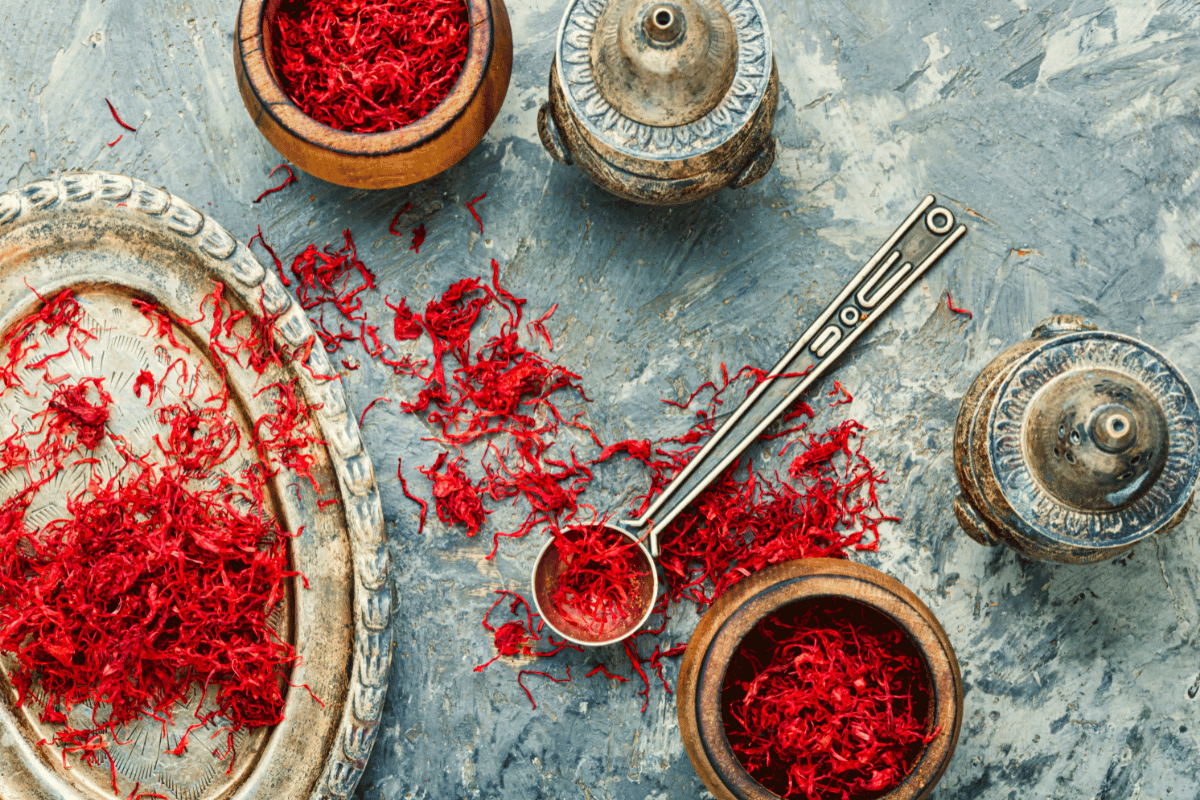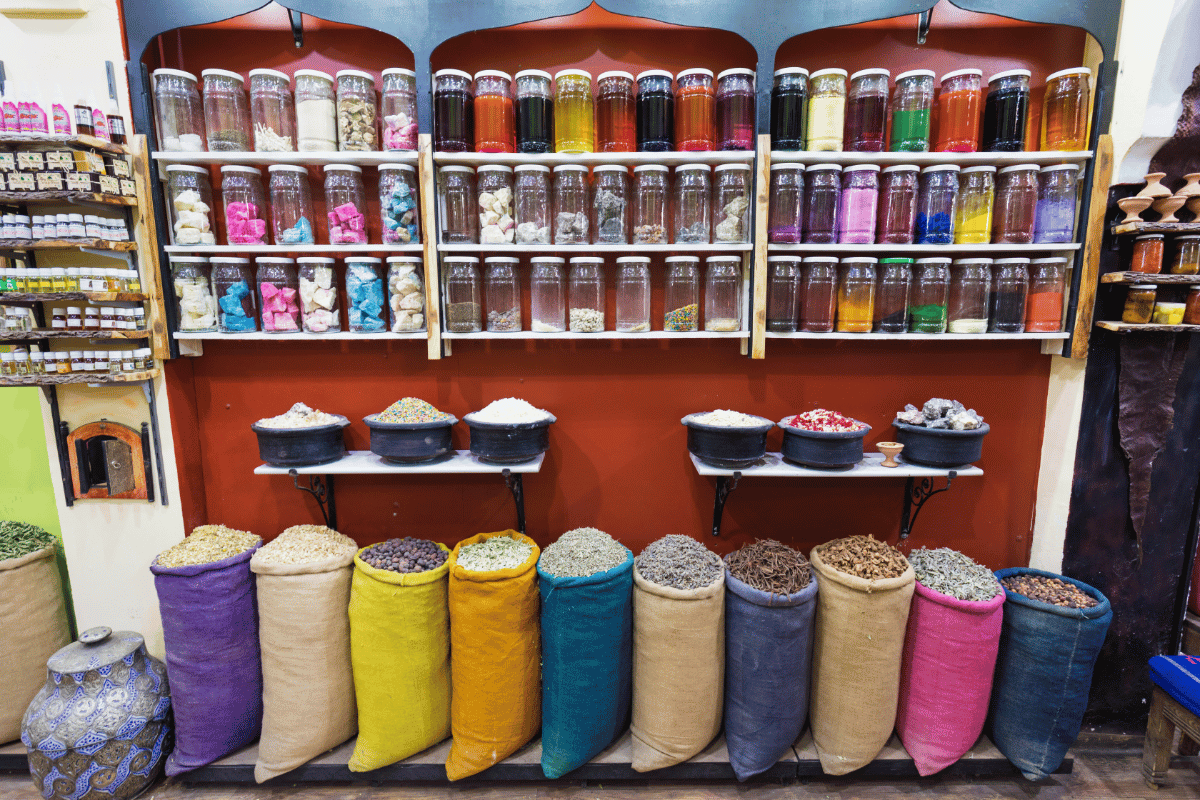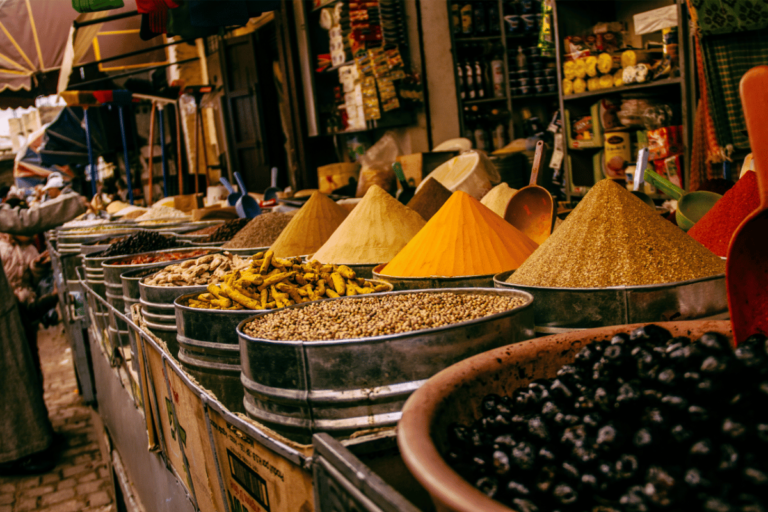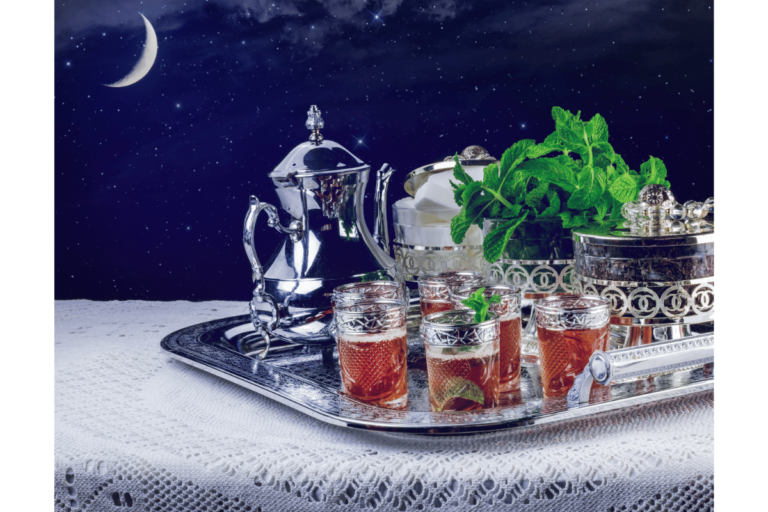Embark on a culinary journey through Morocco, a country known for its rich and diverse flavors that will tantalize your taste buds. With a fascinating blend of Arab, Berber, and French influences, Moroccan cuisine offers a unique sensory experience that is sure to leave you craving for more.
In fact, did you know that Morocco is famous for its spices? The country produces over 70% of the world’s saffron, adding a burst of color and aroma to their delectable dishes.
As you wander through the bustling markets of Marrakech, prepare to be captivated by the vibrant sights and sounds that surround you. The air is filled with the enticing fragrance of freshly ground spices like cumin, coriander, and cinnamon. Stalls are brimming with an array of colorful fruits and vegetables – plump tomatoes, juicy oranges, and fragrant herbs.
Take in the hustle and bustle as locals haggle over prices while artisans showcase their skill in crafting intricate pottery or hand-woven carpets. Be prepared to bargain as well if you want to take home some authentic Moroccan spices or traditional tagine pots!
Exploring the Markets of Marrakech
As you wander through the bustling markets of Marrakech, you can’t help but be enveloped by the intoxicating blend of vibrant colors, fragrant spices, and lively chatter. Exploring the vibrant spices of Marrakech’s markets is a sensory experience like no other.
The air is filled with the aroma of cumin, cinnamon, and saffron, enticing you to sample their exotic flavors. Stalls are lined with an array of spices in every shade imaginable, from fiery red paprika to earthy brown turmeric. Each spice tells a story of Moroccan cuisine and adds depth and complexity to traditional dishes.
In addition to the tantalizing spices, Marrakech’s markets offer a treasure trove of unique handicrafts waiting to be discovered. As you meander through the labyrinthine alleys, you’ll come across stalls brimming with colorful ceramics, intricate metalwork, and delicate textiles. The skilled artisans showcase their craftsmanship in every piece they create.
From hand-painted tagines to intricately woven rugs, each item reflects Morocco’s rich cultural heritage and artistic traditions.
Immersing yourself in Marrakech’s markets is not just about shopping; it’s about immersing yourself in a vibrant tapestry of sights, sounds, and scents that awaken your senses. The bustling atmosphere is alive with vendors haggling over prices while locals go about their daily routines. The marketplaces are a hub of activity where people gather to socialize and exchange stories over cups of steaming mint tea.
With your senses heightened from exploring the markets’ delights for hours on end, it’s time to transition into indulging in traditional Moroccan tagines. These slow-cooked stews are bursting with flavor and are an essential part of Moroccan cuisine. Soothing aromas waft from street-side restaurants as chefs prepare these mouthwatering dishes using an assortment of meats or vegetables cooked alongside fragrant herbs and spices. The tagines are served piping hot, their tender meat falling off the bone, and their rich flavors leaving you craving for more.
Indulging in Traditional Moroccan Tagines
Get ready to embark on a culinary adventure as you dive into the world of traditional Moroccan tagines.
Learn about the different varieties and flavors that make each tagine unique, from aromatic spices to tender meats and fragrant vegetables.
Experience the slow cooking process that allows all the ingredients to meld together, creating a rich and flavorful dish that will tantalize your taste buds.
Don’t miss out on trying vegetarian and seafood tagine options, which offer a delightful twist on this classic Moroccan dish.
Learn about the Different Varieties and Flavors
Imagine yourself walking through the bustling markets of Morocco, where you can’t help but be enticed by the incredible array of different varieties and flavors waiting to be discovered. As you navigate through the maze-like alleyways, your senses are overwhelmed with the aromatic scents wafting from various stalls.
The Moroccan cuisine is known for its rich and diverse flavors, achieved through different cooking techniques and a blend of traditional spices and herbs.
In your culinary exploration, you’ll encounter a multitude of tantalizing options. Here are just a few examples to whet your appetite:
- Fragrant Ras el Hanout: This complex spice blend consists of up to thirty different spices, including cinnamon, cardamom, ginger, cumin, coriander, and turmeric. Its warm and earthy flavor profile adds depth to tagines.
- Zesty Preserved Lemons: These pickled lemons lend a burst of tanginess and brightness to dishes like chicken tagine. Their unique flavor pairs perfectly with other ingredients in traditional Moroccan cuisine.
- Nutty Argan Oil: Derived from argan tree nuts native to Morocco’s southwestern region, this golden oil boasts a distinctive nuttiness that enhances both savory dishes and sweet treats.
- Sweet-Spicy Harissa: Made from roasted red peppers or chilies blended with garlic, olive oil, cumin seeds, coriander seeds, and other spices – harissa brings heat along with layers of robust flavors.
As you sample these delightful ingredients in various dishes throughout your journey in Morocco’s culinary landscape, you’ll soon realize that each one offers something special.
Now that we’ve explored the different varieties and flavors at hand, let’s dive deeper into experiencing the slow cooking process that truly brings out their full potential without compromising any element.

Experience the Slow Cooking Process
Prepare yourself for an unforgettable culinary adventure as you embark on a tantalizing voyage through time, where the slow cooking process transforms ordinary ingredients into extraordinary masterpieces bursting with flavors that’ll make your taste buds dance with joy.
In Morocco, traditional cooking methods involve using slow cooking techniques to extract the maximum flavor from each ingredient. This patient approach allows the spices and aromatics to infuse deeply, resulting in dishes that are rich, aromatic, and full of complexity.
One of the most iconic slow-cooked dishes in Moroccan cuisine is the tagine. Named after the earthenware pot it’s cooked in, this dish is a true testament to the art of slow cooking. The tagine pot creates a unique environment where all the ingredients simmer gently together over low heat for hours on end. As they cook slowly, their flavors meld together harmoniously, creating a symphony of taste that’s simply unmatched. The result is tender meat or vegetables that have absorbed all the fragrant spices and herbs used in the dish.
As you savor these exquisite slow-cooked delights, you’ll be transported to another world filled with intoxicating aromas and mouthwatering flavors.
Now that you’ve experienced the magic of slow cooking techniques and traditional methods, it’s time to explore even more tantalizing options. So let’s journey ahead and discover vegetarian and seafood tagine options that’ll continue to delight your senses like never before!
Try Vegetarian and Seafood Tagine Options
Indulge in the flavorsome world of Moroccan cuisine with a delectable array of vegetarian and seafood tagine options that will leave you craving for more. Whether you’re a vegetarian or simply looking to explore unique flavor combinations, Moroccan cuisine has an abundance of tagine options that are sure to satisfy your taste buds.
From hearty vegetable tagines bursting with aromatic spices to delicate seafood tagines infused with the freshness of the ocean, there is something for everyone to enjoy.
Incorporate an unordered 5 item bullet list in markdown format to create a rhythm and flow in the writing:
- Vegetarian Tagine with Chickpeas and Apricots: Experience the perfect blend of sweetness from dried apricots and earthiness from chickpeas in this delightful vegetarian tagine.
- Seafood Tagine with Shrimp and Calamari: Dive into a sea of flavors with succulent shrimp and tender calamari cooked in a rich tomato-based sauce infused with fragrant herbs.
- Vegetable Tagine with Preserved Lemon: Discover the tangy goodness of preserved lemon as it adds a burst of brightness to an assortment of colorful vegetables simmered to perfection.
- Spicy Eggplant Tagine: Embark on an adventurous culinary journey as you savor the smoky spiciness of eggplant combined with fiery harissa paste, creating a symphony of flavors.
- Mixed Vegetable Tagine: Delight in a medley of seasonal vegetables such as carrots, zucchini, and bell peppers cooked together until tender, resulting in a wholesome and satisfying dish.
With these enticing vegetarian and seafood tagine options at your fingertips, you can easily prepare flavorful meals that’ll transport you straight to Morocco. So why wait? Dive into this culinary adventure and savor every bite!
Transition sentence into subsequent section about ‘savoring Moroccan mint tea’: As you indulge in these tantalizing dishes, don’t forget to complement your meal by savoring the traditional Moroccan mint tea.
Savoring Moroccan Mint Tea
While some may argue that the process of brewing Moroccan Mint Tea is time-consuming, the invigorating aroma and refreshing taste make it well worth the effort. In Morocco, tea ceremonies are an integral part of the culture, and mint tea holds a special place in these traditions. The preparation of this beloved beverage involves steeping green tea leaves with fresh spearmint leaves and sweetening it with sugar. As the hot water infuses with the fragrant leaves, a symphony of scents fills the air, creating an anticipation for what’s to come.
The health benefits of Moroccan Mint Tea are not to be overlooked either. Mint has long been valued for its digestive properties, soothing upset stomachs and aiding digestion after a hearty Moroccan meal. Additionally, the high antioxidant content in green tea makes it a great choice for boosting metabolism and promoting overall wellness. Sipping on a cup of Moroccan Mint Tea not only quenches your thirst but also provides you with a myriad of health benefits.
To truly capture the essence of savoring Moroccan Mint Tea, let me paint you a picture using this table:

As you take your first sip, close your eyes and allow yourself to be transported to Morocco. The fragrant steam rises from your cup, carrying notes of mint that awaken your senses like a gentle breeze on a warm summer day. With each sip, you feel enveloped by warmth and coziness as if nestled by a crackling fireplace on a chilly evening. The freshness of mint revitalizes you from within, leaving you feeling energized and ready to continue your culinary journey through Morocco.
Now that you have savored the delights of Moroccan Mint Tea, it’s time to uncover the secrets of Moroccan couscous. This staple dish holds a special place in Moroccan cuisine and is as versatile as it is delicious. So, let’s embark on another adventure and discover the intricacies of this beloved Moroccan specialty.

Uncovering the Secrets of Moroccan Couscous
Unveiling the mysteries of Moroccan couscous will transport you to a world of flavorful grains and aromatic spices. This traditional dish, dating back centuries, is a staple in Moroccan cuisine and holds deep cultural significance. To truly understand the essence of Moroccan couscous, it’s essential to uncover the traditional techniques used in its preparation.
Firstly, the history of couscous provides valuable insights into this beloved dish. Originating from North Africa, couscous has been consumed for thousands of years by various cultures in the region. It was traditionally made by hand-rolling semolina wheat flour and water into tiny granules. Today, modern methods involve using machinery to produce couscous on a larger scale, but many households still uphold the tradition of making it by hand.
To achieve its distinct flavors and textures, Moroccan couscous relies heavily on spices and cooking techniques passed down through generations. The use of cumin, coriander, turmeric, and cinnamon infuses each grain with a rich aroma that wafts through the air as it simmers gently over low heat. Additionally, steaming is an important step in creating fluffy and tender couscous. Traditionally cooked in a special pot called a ‘keskes,’ this process allows the grains to absorb flavors from the stew beneath while retaining their individuality.
As you delve deeper into understanding Moroccan couscous, you’ll realize that it not only nourishes your body but also connects you with centuries-old traditions. Each bite tells a story steeped in culture and heritage.
Now that we have uncovered some secrets about this iconic dish, let’s move on to sampling Moroccan pastries and desserts—a journey that will satisfy your sweet tooth while continuing our exploration of Morocco’s culinary delights.
Sampling Moroccan Pastries and Desserts
Transitioning seamlessly from exploring savory dishes like Moroccan couscous to indulging in delectable sweets is one way to experience the full breadth of Moroccan cuisine.
Sampling Moroccan Pastries and Desserts
Get ready to satisfy your sweet tooth and embark on a delectable adventure exploring the world of Moroccan pastries and desserts. The rich and diverse culinary traditions of Morocco extend beyond savory dishes like couscous, with an array of mouthwatering treats that will leave you craving for more.
Moroccan pastry recipes are known for their delicate flavors, enticing aromas, and beautiful presentation.
One popular Moroccan pastry is the ‘Kaab el Ghazal,’ also known as ‘Gazelle’s Horns.’ These crescent-shaped cookies are made with a buttery dough filled with almond paste, orange blossom water, and cinnamon. The combination of these ingredients creates a heavenly taste that perfectly balances sweetness and spice. Kaab el Ghazal is often dusted with powdered sugar to give it an elegant touch.
Another classic Moroccan dessert is the ‘M’hanncha,’ which translates to ‘The Snake’ due to its coiled shape resembling a snake. This delectable treat consists of layers of thin almond paste wrapped in phyllo dough, giving it a crispy texture on the outside while remaining moist and gooey on the inside. M’hanncha is often sprinkled with ground cinnamon or drizzled with honey for added sweetness.
Moroccan dessert traditions also include refreshing options like orange blossom water-infused fruit salads or creamy rice pudding flavored with rose water and garnished with almonds or pistachios. These desserts offer a delightful contrast to the warm spices commonly found in Moroccan cuisine.
Sampling Moroccan pastries and desserts is an essential part of any culinary journey through Morocco. From delicate cookies like Kaab el Ghazal to indulgent treats like M’hanncha, there is something for everyone’s sweet cravings. Exploring these traditional recipes allows you to experience the rich flavors and cultural heritage that make Moroccan desserts truly unique.
So indulge your senses and savor every bite as you discover the delightful world of Moroccan pastries and desserts.

Conclusion
As you reach the end of your culinary journey through Morocco, take a moment to savor the memories that’ll linger on your taste buds and in your heart.
From the bustling markets of Marrakech, where vibrant colors and intoxicating aromas fill the air, to the traditional Moroccan tagines that transport you to ancient times, each experience has been an adventure for your senses.
But it isn’t just the flavors that’ve captivated you; it’s also the warmth and hospitality of the Moroccan people. As you indulged in their rich culture, they shared with you their secrets of making perfect mint tea – a refreshing elixir that soothes both body and soul.
And as you uncovered the intricate techniques behind preparing Moroccan couscous, you felt a connection to generations past.
In this journey, every bite of flaky pastry and every spoonful of decadent dessert was like a sweet farewell from Morocco itself. The adage “the way to someone’s heart is through their stomach”rings true as you realize how these culinary delights have touched not only your palate but also your spirit.
So let these memories linger on as reminders of an unforgettable adventure through Morocco – a land where food is love and love is shared with open arms.

The Editorial Team is a passionate group of Morocco enthusiasts dedicated to sharing the beauty, culture, and wonders of this captivating country. With diverse backgrounds and a deep love for travel, we strive to bring you engaging and informative content that inspires your Moroccan adventures. From uncovering hidden gems and sharing local insights to exploring mouthwatering cuisine and showcasing the vibrant lifestyle, our team is committed to providing you with valuable resources and exciting stories that enhance your exploration of Morocco. Join us on this journey as we celebrate the rich heritage and unforgettable experiences that make Morocco truly special.




